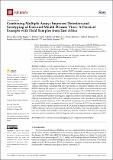| dc.description.abstract | Multiple serotypes and topotypes of foot-and-mouth disease virus (FMDV) circulate in endemic areas, posing considerable impacts locally. In addition, introductions into new areas are of great concern. Indeed, in recent years, multiple FMDV outbreaks, caused by topotypes that have escaped from their original areas, have been recorded in various parts of the world. In both cases, rapid and accurate diagnosis, including the identification of the serotype and topotype causing the given outbreaks, plays an important role in the implementation of the most effective and appropriate measures to control the spread of the disease. In the present study, we describe the performance of a range of diagnostic and typing tools for FMDV on a panel of vesicular samples collected in northern Tanzania (East Africa, EA) during 2012–2018. Specifically, we tested these samples with a real-time RT-PCR targeting 3D sequence for pan-FMDV detection; an FMDV monoclonal antibody-based antigen (Ag) detection and serotyping ELISA kit; virus isolation (VI) on LFBKαVβ6 cell line; and a panel of four topotype-specific real-time RT-PCRs, specifically tailored for circulating strains in EA. The 3D real-time RT-PCR showed the highest diagnostic sensitivity, but it lacked typing capacity. Ag-ELISA detected and typed FMDV in 71% of sample homogenates, while VI combined with Ag-ELISA for typing showed an efficiency of 82%. The panel of topotype-specific real-time RT-PCRs identified and typed FMDV in 93% of samples. However, the SAT1 real-time RT-PCR had the highest (20%) failure rate. Briefly, topotype-specific real-time RT-PCRs had the highest serotyping capacity for EA FMDVs, although four assays were required, while the Ag-ELISA, which was less sensitive, was the most user-friendly, hence suitable for any laboratory level. In conclusion, when the four compared tests were used in combination, both the diagnostic and serotyping performances approached 100%. | en_US |

